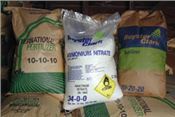UK Specialists Offer Tips To Deal With High Fertilizer Costs

UK specialists have developed an educational video to help forage and livestock producers navigate rising input costs.
Photo courtesy Katie Pratt
KATIE PRATT
PRINCETON, KENTUCKY
Near record-high fertilizer prices, increasing seed costs, supply chain issues and questions about availability have many producers worried about how these challenges are going to affect their profitability in the coming year. University of Kentucky specialists have developed a video to help forage and livestock producers find ways to reduce the effects of rising input costs.
The video and online presentation were developed by Chris Teutsch, forage extension specialist, and John Grove, soil research and extension specialist, and are available on the KY Forages YouTube page https://www.youtube.com/watch?v=sgIS2IBew0M
. “One of the competitive advantages we have in cow-calf systems is nutrient cycling,” said Teutsch, associate extension professor in the UK College of Agriculture, Food and Environment. “If we have a well- managed cow-calf system, we are going to have a very strong nutrient cycle develop over time that needs less fertilizer inputs.”
Cow-calf systems have low nutrient removal because much of the animals’ nutrient intake is digested and released back onto the ground in the form of manure and urine.
Teutsch encouraged producers to take soil samples from their pastures and hayfields.
“Soil tests give us baseline data on soil fertility, so we are not just guessing what our fields need,” Teutsch said. “Soil testing is even more important when fertilizer prices are high because it allows us to fine tune and target our applications to meet our fields’ needs.”
Teutsch and Grove recommended that producers do not apply additional fertilizer if soil test values for phosphorus and potassium are in the medium range until prices moderate or, in the case of hayfields, soil test values drop into the low range. Producers should work with their county extension agents to submit soil samples to UK’s soil testing labs. Agents can also help producers interpret the results.
Application timing is critical when fertilizer prices are high to make sure producers get the most out of their fertilizer dollars. In general, producers should apply nitrogen fertilizer when plants are rapidly growing. However, it is important to remember that the cost of nitrogen fertilizer is only a good deal if producers will use the forage. For example, with cool-season pastures, producers often have more forage than they can effectively use in the spring, so applying nitrogen to stimulate even more growth may not be a good idea.
“That nitrogen dollar may be better spent applying nitrogen in the fall to stimulate growth for winter grazing,” Teutsch said.
Producers can use technology, such as GPS, to their advantage to make sure they are not overlapping nutrient and seed applications.
Soil acidity is a major factor limiting pasture growth in Kentucky.
The good news is that lime prices have not risen as steeply as other inputs.
“If your soil test shows that your fields need lime, now is a good time to apply it,” Grove said. “Lime raises soil pH and helps make soil nutrients more available to plants and legumes, resulting in more efficient use of nutrients that you already have in your soils.”
Producers can implement rotational grazing to improve nutrient distribution and availability across their pastures rather than allowing animals to concentrate nutrients in certain spots, such as near shade or water sources, where animals tend to congregate.
“While this management technique is not new, numerous studies have shown that rotational stocking can increase pasture productivity by 30 percent,” Teutsch said. “There are very few single agricultural practices that can do that.” ∆
KATIE PRATT: University of Kentucky